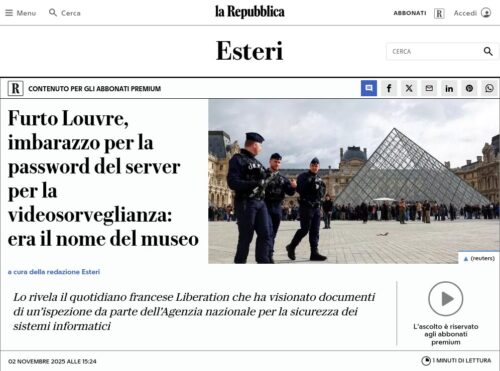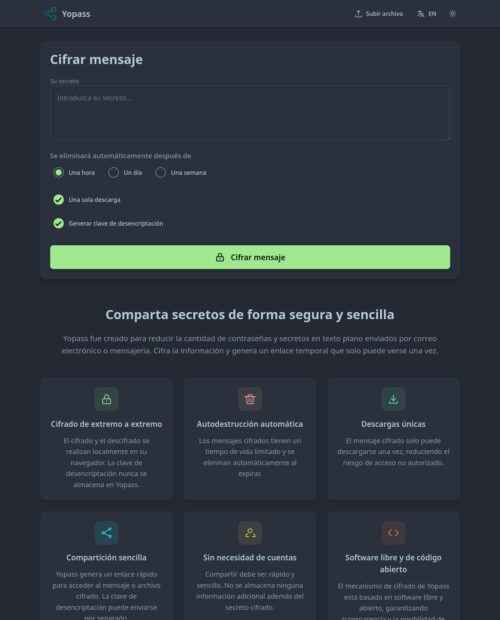Furto Louvre, imbarazzo per la password del server per la videosorveglianza: era il nome del museo


changeme picks up where commercial scanners leave off. It focuses on detecting default and backdoor credentials and not necessarily common credentials. It’s default mode is to scan HTTP default credentials, but has support for other credentials.
changeme is designed to be simple to add new credentials without having to write any code or modules. changeme keeps credential data separate from code. All credentials are stored in yaml files so they can be both easily read by humans and processed by changeme. Credential files can be created by using the ./changeme.py --mkcred tool and answering a few questions.

Yopass fue creado para reducir la cantidad de contraseñas y secretos en texto plano enviados por correo electrónico o mensajería. Cifra la información y genera un enlace temporal que solo puede verse una vez.
Email is an essential service in every business, and the effect of a company losing control over their email service is devastating, even if the company has merged or shut down. Sensitive information and documents are often exchanged over emails between clients, colleagues, vendors and service providers due to the convenience. Consequently, if a bad actor takes control of an entire business’s email service, sensitive information can end up in wrong hands.
I run a shell script on my laptop to block ads, trackers, and malicious websites at the DNS host level. I also use 1.1.1.1 as the DNS resolver on my laptop and phone. This article describes why, alternatives, and trade-offs.
Other comparisons out there are recommending Operating Systems that are long dead or no longer relevant. This is most likely because these «Top 10 Open Source Linux Firewall Software» lists are copied from year to year by non-technical users, without doing the actual comparison.
Some Operating Systems have been superseded or simply stopped being maintained and became irrelevant. You want to avoid such systems because of security reasons – these distros use outdated and have insecure Linux/BSD kernels which can potentially expose you to security exploits.
¿Qué medidas tomas al navegar por internet?. ¿Te proteges contra scripts como javascript y otros, contra la publicidad, el rastreo y el fingerprinting o evitar en lo posible tu huella digital?. ¿Qué navegadores usas en tu ordenador?, ¿usas extensiones en los mismos?
Desde hace años uso Firefox compilado con unos cuantos arreglos. No suelo bloquear demasiado mediante extensiones y sí mediante firewall y el famoso /etc/hosts con miles de dominios y subdominios.
I’ve managed to cobble together a device that is not only dirt cheap for what it does, but is extremely capable in its own right. If you have any interest in building your own home router, I’ll demonstrate here that doing so is not only feasible, but relatively easy to do and offers a huge amount of utility – from traffic shaping, to netflow monitoring, to dynamic DNS.
I built it using the espressobin, Arch Linux Arm, and Shorewall.
The Linksys WRT3200ACM has Tri-Stream 160 technology that doubles bandwidth to help maintain speed better than most dual-band routers. Additional features such as MU-MIMO technology helps each device stay connected to the network at the fastest possible speed without interfering with the performance of other devices.
Linksys’ Smart Wi-Fi smartphone app also lets you manage and monitor your network from anywhere at any given time, but it’s the open-source aspect that really shines for security-focused router buyers, since you can easily use “packages” from trustworthy open source distributions such as OpenWRT or DD-WRT and establish a secure VPN, monitor and analyze network traffic or detect network intrusions instantaneously. Since the firmware packages are all open source, that also means that they’ve been extensively “peer-reviewed” by security experts, making them much more likely to be free of vulnerabilities that hackers can exploit.
Pour donner une idée de l’ampleur du problème, Gabor Szathmari a réenregistré d’anciens noms de domaine pour plusieurs cabinets d’avocats qui avaient fusionné, et mis en place un serveur de courrier électronique. Et, sans rien pirater, il affirme avoir reçu un flux constant d’informations confidentielles, y compris de la correspondance bancaire, des factures d’autres cabinets d’avocats, des documents juridiques sensibles de clients, et des mises à jour LinkedIn. (Il a ensuite restitué les noms de domaine à leurs propriétaires d’origine).
Or, selon le chercheur, il serait facile d’utiliser la même technique pour commettre des fraudes. « En rétablissant une boutique en ligne fonctionnant autrefois sur un nom de domaine désormais abandonné, des acteurs malveillants pourraient télécharger les pages web originales depuis archive.org, puis prendre des commandes et effectuer de nouveaux paiements en se faisant passer pour une boutique en ligne tout à fait fonctionnelle », a-t-il déclaré par courriel. « Si l’ancienne boutique en ligne disposait d’un système de gestion de la relation client (CRM) ou d’un MailChimp, les criminels pourraient accéder à la liste des anciens clients en reprenant ces comptes avec un mot de passe réinitialisé par courrier électronique »
Read the BASICS to find out how online surveillance works. Dive into our TOOL GUIDES for instructions to installing our pick of the best, most secure applications. We have more detailed information in our FURTHER LEARNING sections. If you’d like a guided tour, look for our list of common SECURITY SCENARIOS.
In all, the SSH connection requires two key pairs –
Your Client software checks the Server’s (host) public key against data the server sends encrypted with the host private key. This requires you to have a copy of its public key, which you’re handed at the first connection and your client stores if you approve of it.
The Server checks your authentication data encrypted with your user private key using the copy of your user public key that it has a copy of because you put it there (or had someone put there for you).
El ciberataque al Ayuntamiento de Jerez ha dejado sin prácticamente ningún servicio informático a todo el ayuntamiento, sin embargo, posiblemente el único servidor importante con GNU/Linux en el Ayuntamiento de Jerez sigue funcionando, permitiendo que los distintos departamentos al menos no estén incomunicados.
Check if you have an account that has been compromised in a data breach
está la aproximación íntima y personal a la gestión de las claves, en contraposición a la aproximación colectiva o comunal. He visto a varios colectivos compartir la contraseña de una cuenta de correo electrónico, Facebook, o Twitter, que son del colectivo y se gestionan de forma grupal. Obviamente no es la mejor forma de gestionar y resguardar la información de nuestro colectivo, pero es valioso recordar que en grupos militantes de gran parte del sur global seguramente lo «privado» se entiende de forma diferente que en el norte, y las más de las veces cruza lo personal y llega a lo colectivo.
Si hablamos de cuentas de correo electrónico es fácil decir: pues hay que usar una lista de correos en vez. Pero se complica si hablamos de plataformas como Twitter que no están diseñadas para las colectividades, al contrario, fomentan el individualismo y el «leadership» informativo.
Otro punto interesante es que tenemos que plantearnos radicalmente cómo es que hacemos las capacitaciones. No se trata de enseñar herramientas, asumiendo demasiado rápido dónde están los problemas. Varios procesos de aprendizaje tienden a fracasar porque son como la misa cristiana: todas hacemos reconocimiento de culpa y en la euforia del momento prometemos mejorar, y luego hacemos unas claves GPG larguísimas y super buenas pero que acaban inservibles porque a los tres meses de no usarlas nos las olvidamos
Es como lo de la mooncup: no porque nos digan que es lo mejor tiene necesariamente que resultarnos fácil, ni cómodo.
Por ahora, esa idea: afirmar nuestro derecho a la intimidad, también en la red. Y de poner una llave del tamaño que queramos, aunque luego, en casa, la pongamos bajo la alfombra porque así nos viene en gana.
Confidential Mode will push users further into Google’s own walled garden while giving them what we believe are misleading assurances of privacy and security.
It’s important to note at the outset that because Confidential Mode emails are not end-to-end encrypted, Google can see the contents of your messages and has the technical capability to store them indefinitely, regardless of any “expiration date” you set. In other words, Confidential Mode provides zero confidentiality with regard to Google.
But that’s only the beginning of the problems with Gmail’s new built-in IRM. Indeed, the security properties of the system depend not on the tech, but instead on a Clinton-era copyright statute. Under Section 1201 of the 1998 Digital Millennium Copyright Act (“DMCA 1201”), making a commercial product that bypasses IRM is a potential felony, carrying a five-year prison sentence and a $500,000 fine for a first offense. DMCA 1201 is so broad and sloppily drafted that just revealing defects in Google IRM could land you in court.
We believe that using the term “Confidential Mode” for a feature that doesn’t provide confidentiality as that term is understood in infosec is misleading.
Un cliente de mensajería que no depende de servidores centralizados, usa la red Tor para ofrecer comunicaciones cifradas de extremo a extremo y es de código abierto.
A diferencia de las aplicaciones de mensajería tradicionales, Briar no depende de un servidor central – los mensajes se sincronizan directamente entre los dispositivos de los usuarios. Los mensajes se envían a través de la red Tor, protegiendo a los usuarios y en caso de que Internet no funcione, puede sincronizarse vía Bluetooth o Wi-Fi.
Su sistema para añadir contactos tampoco es convencional ya que, se genera un código que la persona a añadir debe escanear con su dispositivo móvil. De esta forma se busca que haya un encuentro físico entre el usuario y el futuro contacto. La lista de contacto se cifra y se almacena localmente en cada dispositivo.
Password management should be simple and follow Unix philosophy. With pass, each password lives inside of a gpg encrypted file whose filename is the title of the website or resource that requires the password. These encrypted files may be organized into meaningful folder hierarchies, copied from computer to computer, and, in general, manipulated using standard command line file management utilities.
pass makes managing these individual password files extremely easy. All passwords live in ~/.password-store, and pass provides some nice commands for adding, editing, generating, and retrieving passwords. It is a very short and simple shell script. It’s capable of temporarily putting passwords on your clipboard and tracking password changes using git.
The command-line option –gen-key is used to create a new primary keypair.
If a list has a custom field for a GPG Public Key set then subscribers can upload their GPG public key to receive encrypted messages from the list.
Pourquoi donc l’opérateur télécom [Orange] s’est-il décidé à investir dans le secteur de la cybersécurité ? Justement parce que c’est un opérateur. Son réseau, ses millions de données sont des cibles de choix pour les pirates. De sa fragilité, Orange a donc décidé de faire un business.